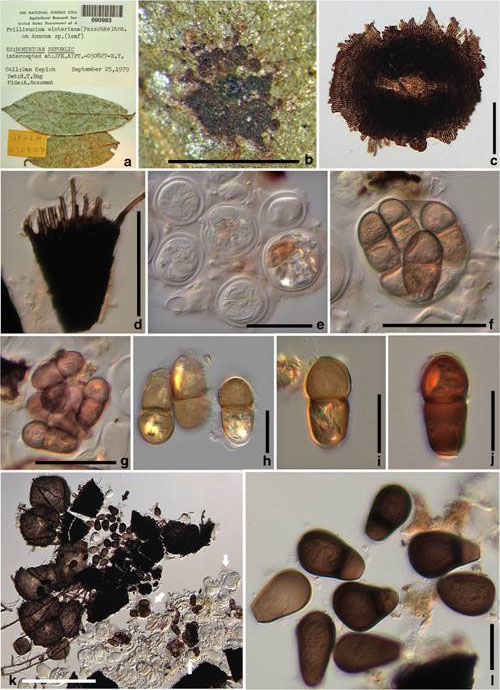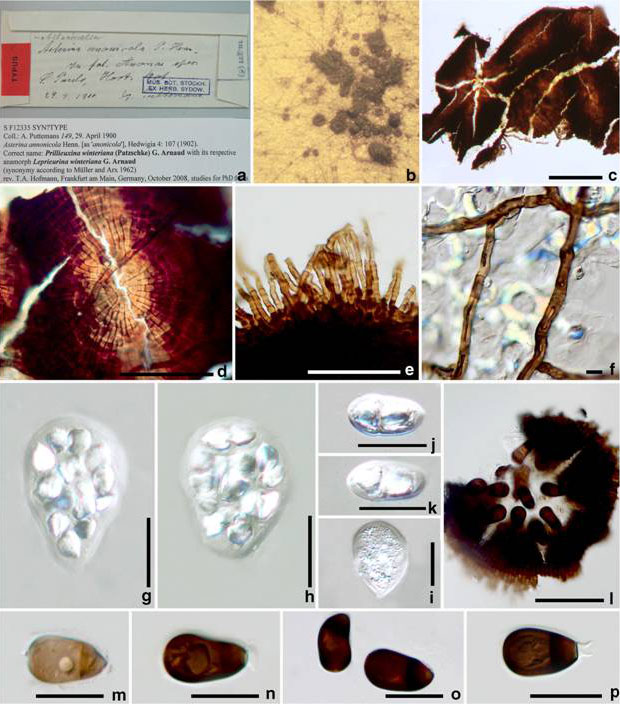Prillieuxina winteriana (Pazschke) G. Arnaud, Annals d’École National d’Agric. de Montpellier, Série 2 16(1–4): 162 (1918)
≡ Asterina winteriana Pazschke, Hedwigia 31(3): 104(1892)
= Asterina annonicola Henn. [as ‘anonicola’], Hedwigia41: 107 (1902)
≡ Asteridiella winteriana (Pazschke) Theiss., Brotéria, sér. bot. 10(2): 122 (1912)
= Leprieurina winteriana G. Arnaud, Annals d’École National d’Agric. de Montpellier, Série 2 16(1–4): 211 (1918) [1917] Type: S-F12335.
Epiphytes on the upper leaf host surface, forming minute, scattered, blackened areas. Superficial hyphae abundant in the host surface, easily removed from the host, appressoria not observed, but haustoria present under thyriothecia (latter reported by Arnaud 1918). Sexual state: Thyriothecia 300– 700μm diam., superficial on the host, flattened, black, with basal peridium poorly developed, opening by central, stellate fissures. Upper wall linear, with compressed hyphae arranged radially from the centre toward the margin. Hamathecium lacking pseudoparaphyses. Asci 39–46μm diam (x = 43μm, n = 10), 8-spored, bitunicate, globose-subglobose, apedicellate, without an ocular chamber. Ascospores 30–37× 15–19μm (x = 34×17μm, n=10), overlapping 3–5-seriate, ellipsoidal with rounded ends, 1-septate, constricted at the septum, light brown to reddish-brown, smooth-walled. Asexual state: “Leprieurina” , coelomyceteous, Pycnothyriothecia same as sexual state. Conidia 30–36×20– 22.5μm (x= 33×21μm, n=10), obovoid, widest near the apex and tapering towards lower end, sometimes 1-septate at lower cell, not constricted at the septum, brown to dark brown.
Material examined: BRAZIL, Leopoldo Rio Grande Do Sul, on surface of leaves of Annona sp. (Annonaceae), 29 April 1900, A Puttemans 149 (S-F12335, syntype); DOMINICAN REPUBLIC, on leaves of Annona sp., intercepted JFK International Airport, New York 030827, 25 September 1979. D. Kepich, determined H.T. Eng, and A.Y. Rossman (BPI 690983).
Notes: We illustrate the type specimen of Prillieuxina winteriana and a specimen from leaves of the same host family, Annona, from the Dominican Republic. The type specimen was collected on leaves of Rollinia in Brazil. The ascospores in the specimen we examined are larger (30–37× 15–19μm) than those reported for Asterina winteriana (27– 32×14–16μm), and those reported for Asterina annonicola (27×12μm) on which Arnaud (1918) based his generic concept. The asexual “Leprieurina” state was found in association with the asexual state and is also illustrated.
Fig. 1 Prillieuxina winteriana (BPI 690983). a Herbarium label and specimens. b Fungal thallus on host surface. c, d Squash mount of thyriothecium showing peridial wall. e–g Immature and mature asci. h– j Ascospores. k, l Conidia. Note asci and ascospores indicated white arrows, and conidia indicated black arrow. Scale bars: b=1 mm, k= 200μm, c, d=100μm, e–g=50μm, h–j, l=20μm
Fig. 2 Prillieuxina winteriana (syntype). a Material label. b Thyriothecia on host surface. c–e Squash mount of thyriothecium showing peridial wall. f Superficial hyphae. g–i Asci. j, k Ascospores. l Pycnothyria of asexual state. m Immature conidia. n–p Mature conidia. Scale bars: f=5μm, c–e, g–k, m–p=20μm, l=50μm


